Carl E. Olson's Blog, page 159
April 2, 2013
Knights for Peace and Sanctification in the Middle East
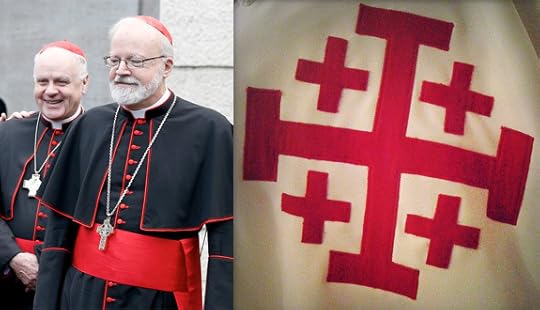
Knights for Peace and Sanctification in the Middle East | William L. Patenaude | Catholic World Report
The Equestrian Order of the Holy Sepulchre of Jerusalem works to support the people and shrines of the Holy Land.
Almost a thousand years after its founding, an order of crusader knights remains active in the Holy Land. Its mission is not armed battle but the carrying out of the order’s original ideals: personal holiness, evangelization, defense of the weak, and charity towards all. Its members also pledge to support the upkeep of the shrines where Christ was born, prayed, mounted his cross, and rose from the dead.
Founded soon after the First Crusade, the pontifical Equestrian Order of the Holy Sepulchre of Jerusalem currently has some 28,000 clerical, religious, and lay members across the globe. While the order’s titles, regalia, and ceremonies of investiture come with great honor and dignity (and a rigorous nomination process), membership comes with a lifetime pledge of spiritual and worldly support for the Holy Land. As a result, the order offers countless prayers and millions of dollars annually to build, operate, maintain, and expand schools, youth centers, hospitals, seminaries, homes for religious, pre- and post-natal clinics, and the only Catholic institution of higher education in Israel, Bethlehem University.
“Our primary aim is personal sanctification,” stresses Cardinal Edwin O’Brien, Grand Master of the worldwide order. “I am convinced that with this focus on holiness, the charism [to support the people and shrines of the Holy Land] comes into full bloom.”
The charitable order grew out of the need to govern Jerusalem after Godfrey de Bouillon and his crusaders freed the city from Muslim control in July 1099. The resulting “Order of Canons” included knights who had exhibited noticeable leadership skills and Christian charity. These soldiers-turned-protectors would take the Augustinian Rule of poverty and obedience and swear to defend the Holy Sepulchre (the site of Christ’s resurrection) and other Christian shrines.
Over time, many of the knights returned to Europe and Muslim armies retook Jerusalem. But with the aid of political and ecclesial encouragement, the Equestrian Order of the Holy Sepulchre of Jerusalem founded priories throughout Europe that kept alive its original oaths and charitable goals. With the restoration of Jerusalem’s Latin Patriarchate in 1847, Pope Pius IX placed the order under the full protection of the Holy See. A century later, Pius XII ordered that a prince of the Church would hold the role of the order’s Grand Master. Subsequent pontiffs brought even more structure.
What has not changed, however, is the order’s commitment to the Bishop of Rome and to Jerusalem’s Latin Patriarch. The order thus serves as a bridge between the Church in the West and the people in the Middle East—especially Christians, who often find themselves caught in the midst of the regional political, social, and economic difficulties.
“The Christian minority living in the Holy Land increasingly faces the challenge of practicing their faith in the midst of conflict and turmoil,” said Cardinal Sean O’Malley, OFM, Cap., archbishop of Boston and Grand Prior of the order’s Northeast United States Lieutenancy.
April 1, 2013
New: "On Heaven and Earth" by Jorge Mario Bergoglio (Pope Francis)
Available on April 30, 2013 from Ignatius Press: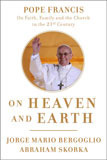 On Heaven and Earth: Pope Francis on Faith, Family, and the Church in the Twenty-First Century
On Heaven and Earth: Pope Francis on Faith, Family, and the Church in the Twenty-First Century
by Jorge Mario Bergoglio and Abraham Skorka
224 pp | Hardcover
From the man who became Pope Francis--Jorge Mario Bergoglio shares his thoughts on religion, reason, and the challenges the world faces in the 21st century with Abraham Skorka, a rabbi and biophysicist.
For years Cardinal Jorge Mario Bergoglio, archbishop of Argentina, and Rabbi Abraham Skorka were tenacious promoters of interreligious dialogues on faith and reason. They both sought to build bridges among Catholicism, Judaism, and the world at large. On Heaven and Earth, originally published in Argentina in 2010, brings together a series of these conversations where both men talked about various theological and worldly issues, including God, fundamentalism, atheism, abortion, homosexuality, euthanasia, same-sex marriage, and globalization.
From these personal and accessible talks comes a first-hand view of the man who would become pope to 1.2 billion Catholics around the world in March 2013.
"See How the Church Is Alive Today!"
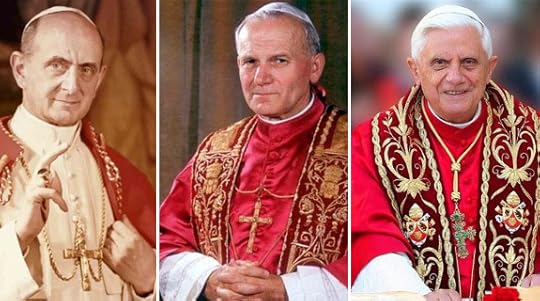
"See How the Church Is Alive Today!" | Paul Erich Menge | CWR blog
The last forty years have witnessed a flowering of faith in the Church, despite numerous challenges and difficulties
"But we see how the Church is alive today!" — Benedict XVI, Final General Audience, Feb. 27, 2013.
Upheaval
in the Church and confusion among the faithful. The late 1960s and early 1970s were dark days indeed, as
reported by Kenneth L. Woodward in his memoir of big changes to the Church in
the wake of the Second Vatican Council, in the February 2013
issue of the journal First Things.
Woodward at that time was religion editor at Newsweek magazine.
But
Woodward’s account takes us only into 1971. It is only the beginning of the story. Then, gradually, came a flowering, the
evidentiary work of the Holy Spirit, a great happening, a turn in salvation
history.
First
stirrings were the emergence of the Catholic Charismatic Renewal in February
1967 with its appreciation for the work of the Holy Spirit, which spread
throughout the Church; publication in 1971 of Malcolm Muggeridge’s Something
Beautiful for God,
which brought to the public’s attention the ministry of Mother Teresa of
Calcutta and her Missionaries of Charity; founding of the international journal
Communio
in 1972 by Joseph Ratzinger and other prominent theologians who in 1970 broke
with the progressive journal Concilium; the Roe v. Wade Supreme Court decision
in January 1973 which prompted into existence the anti-abortion/pro-life
movement; appointment of Fr. Michael Scanlan in 1974 to be president of the
College of Steubenville and to begin the rescue and spiritual transformation of
the college (re-named Franciscan University of Steubenville in 1985); and the
“Hartford Appeal for Theological Affirmation” of February 1975, which was a
response of fourteen Christian thinkers to current distortions of Christian
faith, “the casual jettisoning of Christian orthodoxy,” and included
identification of thirteen “false and debilitating” theses.
Multiple
fruits of the Spirit appeared in the late 1970s and early 1980s, most notably
the papacy of Bl. John Paul II, beginning in 1978 and continuing for 27 years.
Vatican II and the “Bad News” of the Gospel
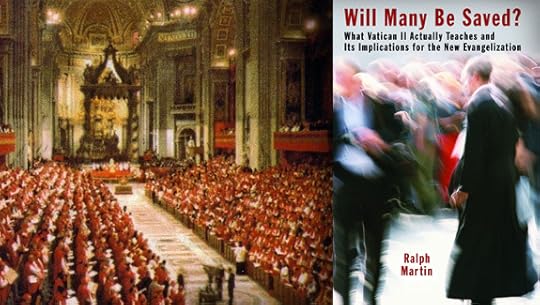
Vatican II and the “Bad News” of the Gospel | David Paul Deavel | Catholic World Report
Ralph Martin’s new book clarifies what the Council actually taught about salvation outside the Church.
Ruefully observing statistics
showing that only 6 percent of American Catholic parishes considered evangelism
a priority, the late Cardinal Avery Dulles once lamented, “The Council has
often been interpreted as if it had discouraged evangelization.” Ralph Martin’s new book, Will Many Be
Saved? What Vatican II Actually Teaches
and Its Implications for the New Evangelization, aims to explain why this
interpretation has taken root despite the fact that the Council documents,
particularly the keystone document Lumen Gentium (LG), are brimming with
talk about evangelization as the Church’s main job. In fact, Paul VI’s
encyclical Evangelii Nuntiandi stated that the objectives of the Council
were summed up in one statement: “to
make the Church of the 20th century ever better fitted for proclaiming the
Gospel.” Yet the opposite happened.
Martin thinks, and with reason,
that the loss of impetus to evangelize is based upon the widespread notion
after the Council that almost everybody will be saved—except maybe really evil
people like Hitler and Judas. Having the sacraments or an explicit faith in
Christ is seen as a nice add-on. But essentially the theology of salvation
could be summed up by the 1989 cartoon movie All Dogs Go to Heaven.
Of course this theology had
backing from big names. Karl Rahner declared that the Council had a
“theological optimism…concerning salvation.” Richard McBrien’s commentary on LG
claimed that the Church now considered the human race as “an essentially saved
community from whom a few may, by the exercise of their own free will, be
lost.” Even the Jesuit scholar Francis Sullivan, author of a very careful study
of the teaching on salvation outside the Church, tended in his more popular
writings to throw caution to the wind and claim a “general presumption of
innocence which is now the official attitude of the Catholic Church.” These
claims were never undergirded by any actual citations or close readings from
the Council, which marked a doctrinal development indeed, but not one of
automatic salvation or “presumed innocence.”
While the question of the
salvation of those who have never heard the Gospel has been bubbling up in a
new way since the 16th-century discovery of peoples in the New World, it had
been coming to a steady boil over more than 100 years before Vatican II.
March 31, 2013
"The Truth of the Resurrection" by Joseph Cardinal Ratzinger

The Truth of the Resurrection | Joseph Cardinal Ratzinger | From
Introduction to Christianity
To the Christian, faith in the Resurrection of Jesus Christ is an expression of certainty that
the saying that seems to be only a beautiful dream is in fact true: "Love
is strong as death" (Song 8:6). In the Old Testament this sentence comes
in the middle of praises of the power of eros. But this by no means signifies that we can simply
push it aside as a lyrical exaggeration. The boundless demands of eros", its apparent exaggerations and extravagance, do in
reality give expression to a basic problem, indeed the" basic problem of human existence, insofar as they
reflect the nature and intrinsic paradox of love: love demands infinity,
indestructibility; indeed, it is, so to speak, a call for infinity. But it is
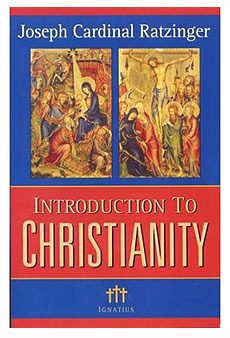
also a fact that this cry of love's cannot be satisfied, that it demands
infinity but cannot grant it; that it claims eternity but in fact is included
in the world of death, in its loneliness and its power of destruction. Only
from this angle can one understand what "resurrection" means. It is" the greater strength of love in face of death.
At the same time it is proof of what only immortality can create: being in the
other who still stands when I have fallen apart. Man is a being who himself
does not live forever but is necessarily delivered up to death. For him, since
he has no continuance in himself, survival, from a purely human point of view,
can only become possible through his continuing to exist in another. The
statements of Scripture about the connection between sin and death are to he
understood from this angle. For it now becomes clear that man's attempt
"to be like God", his striving for autonomy, through which he wishes
to stand on his own feet alone, means his death, for he just cannot stand on
his own. If man--and this is the real nature of sin--nevertheless refuses to
recognize his own limits and tries to be completely self-sufficient, then
precisely by adopting this attitude he delivers himself up to death.
Of course man does understand that his life alone does not endure and that he
must therefore strive to exist in others, so as to remain through them and in
them in the land of the living. Two ways in particular have been tried. First,
living on in one's own children: that is why in primitive peoples failure to
marry and childlessness are regarded as the most terrible curse; they mean
hopeless destruction, final death. Conversely, the largest possible number of
children offers at the same time the greatest possible chance of survival, hope
of immortality, and thus the most genuine blessing that man can expect. Another
way discloses itself when man discovers that in his children he only continues
to exist in a very unreal way; he wants more of himself to remain. So he takes
refuge in the idea of fame, which should make him really immortal if be lives
on through all ages in the memory of others. But this second attempt of man's
to obtain immortality for himself by existing in others fails just as badly as
the first: what remains is not the self but only its echo, a mere shadow. So
self-made immortality is really only a Hades, a sheol": more nonbeing than being. The inadequacy of both ways
lies partly in the fact that the other person who holds my being after my death
cannot carry this being itself but only its echo; and even more in the fact
that even time other person to whom I have, so to speak, entrusted my
continuance will not last--he, too, will perish.
This leads us to the next step. We have seen so far that man has no permanence
in himself. And consequently can only continue to exist in another but that his
existence in another is only shadowy and once again not final, because this
other must perish, too. If this is so, then only one could truly give lasting
stability: he who is, who does not come into existence and pass away again but
abides in the midst of transience: the God of the living, who does not hold
just the shadow and echo of my being, whose ideas are not just copies of
reality. I myself am his thought, which establishes me more securely, so to
speak, than I am in myself; his thought is not the posthumous shadow but the
original source and strength of my being. In him I can stand as more than a shadow;
in him I am truly closer to myself than I should be if I just tried to stay by
myself.
Before we return from here to the Resurrection, let us try to see the same
thing once again from a somewhat different side. We can start again from the
dictum about love and death and say: Only where someone values love more highly
than life, that is, only where someone is ready to put life second to love, for
the sake of love, can love be stronger and more than death. If it is to be more
than death, it must first be more than mere life. But if it could be this, not
just in intention but in reality, then that would mean at the same time that
the power of love had risen superior to the power of the merely biological and
taken it into its service. To use Teilhard de Chardin's terminology; where that
took place, the decisive complexity or "complexification" would have occurred;
bios, too, would be encompassed
by and incorporated in the power of love. It would cross the boundary--death--and
create unity where death divides. If the power of love for another were so
strong somewhere that it could keep alive not just his memory, the shadow of
his "I", but that person himself, then a new stage in life would have
been reached. This would mean that the realm of biological evolutions and
mutations had been left behind and the leap made to a quite different plane, on
which love was no longer subject to bios but made use of it. Such a final stage of "mutation" and
"evolution" would itself no longer be a biological stage; it would
signify the end of the sovereignty of bios, which is at the same time the sovereignty of death; it would open up
the realm that the Greek Bible calls zoe, that is, definitive life, which has left behind the rule of death.
The last stage of evolution needed by the world to reach its goal would then no
longer be achieved within the realm of biology but by the spirit, by freedom,
by love. It would no longer be evolution but decision and gift in one.
But what has all this to do, it may be asked, with faith in the Resurrection of
Jesus? Well, we previously considered the question of the possible immortality
of man from two sides, which now turn out to be aspects of one and. the same state
of affairs. We said that, as man has no permanence in himself, his survival
could. only be brought about by his living on in another. And we said, from the
point of view of this "other", that only the love that takes up the
beloved in itself, into its own being, could make possible this existence in
the other. These two complementary aspects are mirrored again, so it seems to
me, in the two New Testament ways of describing the Resurrection of the Lord:
"Jesus has risen" and "God (the Father) has awakened
Jesus." The two formulas meet in the fact that Jesus' total love for men,
which leads him to the Cross, is perfected in totally passing beyond to the
Father and therein becomes stronger than death, because in this it is at the
same time total "being held" by him.
From this a further step results. We can now say that love always establishes
some kind of immortality; even in its prehuman stage, it points, in the form of
preservation of the species, in this direction. Indeed, this founding of
immortality is not something incidental to love, not one thing that it does
among others, but what really gives it its specific character. This principle
can be reversed; it then signifies that immortality always" proceeds from love, never out of the autarchy of
that which is sufficient to itself. We may even be bold enough to assert that
this principle, properly understood, also applies even to God as he is seen by
the Christian faith. God, too, is absolute permanence, as opposed to everything
transitory, for the reason that he is the relation of three Persons to one
another, their incorporation in the "for one another" of love,
act-substance of the love that is absolute and therefore completely
"relative", living only "in relation to". As we said
earlier, it is not autarchy, which knows no one but itself, that is divine;
what is revolutionary about the Christian view of the world and of God, we
found, as opposed to those of antiquity, is that it learns to understand the
"absolute" as absolute "relatedness", as relatio
subsistens.
To return to our argument, love is the foundation of immortality, and
immortality proceeds from love alone. This statement to which we have now
worked our way also means that he who has love for all has established
immortality for all. That is precisely the meaning of the biblical statement that
his Resurrection is our life.
The--to us--curious reasoning of St. Paul in his First Letter to the
Corinthians now becomes comprehensible: if he has risen, then we have, too, for
then love is stronger than death; if he has not risen, then we have not either,
for then the situation is still that death has the last word, nothing else (cf.
I Cor 15:16f.). Since this is a statement of central importance, let us spell
it out once again in a different way: Either love is stronger than death, or it
is not. If it has become so in him, then it became so precisely as love for
others. This also means, it is true, that our own love, left to itself, is not
sufficient to overcome death; taken in itself it would have to remain an
unanswered cry. It means that only his love, coinciding with God's own power of
life and love, can be the foundation of our immortality. Nevertheless, it still
remains true that the mode of our immortality will depend on our mode of
loving. We shall have to return to this in the section on the Last Judgment.
A further point emerges from this discussion. Given the foregoing
considerations, it goes without saying that the life of him who has risen from
the dead is not once again bios, the biological form of our mortal life within
history; it is zoe, new,
different, definitive life; life that has stepped beyond the mortal realm of
bios and history, a realm that has here been surpassed by a greater power. And
in fact the Resurrection narratives of the New Testament allow us to see
clearly that the life of the Risen One lies, not within the historical bios,
but beyond and above it. It is also true, of course, that this new life begot
itself in history and had to do so, because after all it is there for history,
and the Christian message is basically nothing else than the transmission of
the testimony that love has managed to break through death here and thus has
transformed fundamentally the situation of all of us. Once we have realized
this, it is no longer difficult to find the right kind of hermeneutics for the
difficult business of expounding the biblical Resurrection narratives, that is,
to acquire a clear understanding of the sense in which they must properly be
understood. Obviously we cannot attempt here a detailed discussion of the
questions involved, which today present themselves in a more difficult form
than ever before; especially as historical and--for the most part inadequately pondered--philosophical
statements are becoming more and more inextricably intertwined, and exegesis
itself quite often produces its own philosophy, which is intended to appear to the
layman as a supremely refined distillation of the biblical evidence. Many
points of detail will here always remain open to discussion, but it is possible
to recognize a fundamental dividing line between explanation that remains
explanation and arbitrary adaptations [to contemporary ways of thinking].
First of all, it is quite clear that after his Resurrection Christ did not go
back to his previous earthly life, as we are told the young man of Nain and
Lazarus did. He rose again to definitive life, which is no longer governed by
chemical and biological laws and therefore stands outside the possibility of
death, in the eternity conferred by love. That is why the encounters with him
are "appearances"; that is why he with whom people had sat at table
two days earlier is not recognized by his best friends and, even when
recognized, remains foreign: only where he grants vision is he
seen; only when he opens men's eyes and makes their hearts open up can the countenance
of the eternal love that conquers death become recognizable in our mortal
world, and, in that love, the new, different world, the world of him who is to
come. That is also why it is so difficult, indeed absolutely impossible, for the
Gospels to describe the encounter with the risen Christ; that is why they can
only stammer when they speak of these meetings and seem to provide
contradictory descriptions of them. In reality they are surprisingly unanimous
in the dialectic of their statements, in the simultaneity of touching and not
touching, or recognizing and not recognizing, of complete identity between the
crucified and the risen Christ and complete transformation. People recognize
the Lord and yet do not recognize him again; people touch him, and yet he is untouchable;
he is the same and yet quite different. As we have said, the dialectic is always
the same; it is only the stylistic means by which it is expressed that changes.
For example, let us examine a little more closely from this point of view the
Emmaus story, which we have already touched upon briefly. At first sight it
looks as if we are confronted here with a completely earthly and material
notion of resurrection; as if nothing remains of the mysterious and indescribable
elements to be found in the Pauline accounts. It looks as if the tendency to
detailed depiction, to the concreteness of legend, supported by the apologist's
desire for something tangible, had completely won the upper hand and fetched
the risen Lord right back into earthly history. But this impression is soon
contradicted by his mysterious appearance and his no less mysterious
disappearance. The notion is contradicted even more by the fact that here, too,
he remains unrecognizable to the accustomed eye. He cannot be firmly grasped as
he could be in the time of his earthly life; he is discovered only in the realm
of faith; he sets the hearts of the two travelers aflame by his interpretation
of the Scriptures and by breaking bread he opens their eyes. This is a
reference to the two basic elements in early Christian worship, which consisted
of the liturgy of the word (the reading and expounding of Scripture) and the
eucharistic breaking of bread. In this way the evangelist makes it clear that
the encounter with the risen Christ lies on a quite new plane; he tries to describe
the indescribable in terms of the liturgical facts. He thereby provides both a
theology of the Resurrection and a theology of the liturgy: one encounters the risen
Christ in the word and in the sacrament; worship is the way in which he becomes
touchable to us and, recognizable as the living Christ. And conversely, the
liturgy is based on the mystery of Easter; it is to he understood as the Lords approach
to us. In it he becomes our traveling companion, sets our dull hearts aflame,
and opens our sealed eyes. He still walks with us, still finds us worried and
downhearted, and still has the power to make us see.
Of course, all this is only half the story; to stop at this alone would mean
falsifying the evidence of the New Testament. Experience of the risen Christ is
something other than a meeting with a man from within our history, and it must certainly
not be traced back to conversations at table and recollections that would have
finally crystallized in the idea that he still lived and went about his business.
Such an interpretation reduces what happened to the purely human level and robs
it of its specific quality. The Resurrection narratives are something other and
more than disguised liturgical scenes: they make visible the founding event on
which all Christian liturgy rests. They testify to an approach that did not
rise from the hearts of the disciples but came to them from outside, convinced
them despite their doubts and
made them certain that the Lord had truly risen. He who lay in the grave is no longer
there; he--really he himself--lives. He who had been transposed into the other
world of God showed himself powerful enough to make it palpably clear that he
himself stood in their presence again, that in him the power of love had really
proved itself stronger than the power of death.
Only by taking this just as seriously as what we said first does one remain
faithful to the witness borne by the New Testament; only thus, too, is its
seriousness in world history preserved. The comfortable attempt to spare
oneself the belief in the mystery of God's mighty actions in this world and yet
at the same time to have the satisfaction of remaining on the foundation of the
biblical message leads nowhere; it measures up neither to the honesty of reason
nor to the claims of faith. One cannot have both the Christian faith and
"religion within the bounds of pure reason"; a choice is unavoidable.
He who believes will see more and more clearly, it is true, how rational it is
to have faith in the love that has conquered death.
The Logic of the Resurrection
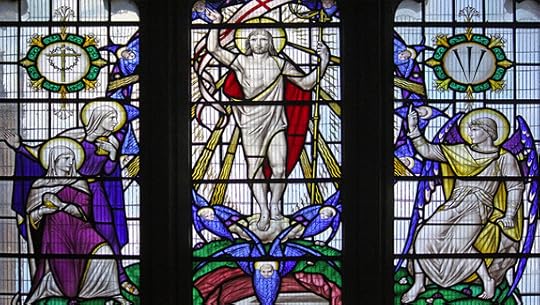
The Logic of the Resurrection | Fr. James V. Schall, SJ | Catholic World Report
The truth of the resurrection of the body is bound up with the question of justice.
The
resurrection of the body is not primarily a question of logic. It is a question
of fact, of witness. We do not begin from a philosophical theory to deduce the
resurrection of the body. Rather we start from the fact of the resurrection of
Christ. We ask whether it makes sense, whether it is “reasonable” in some basic
manner. In this sense, philosophy follows fact, provided we can accept the
facts of what is.
In his
book, Jesus
of Nazareth: Holy Week, Benedict XVI examined all the evidence that would argue
that the resurrection as a fact did not happen. He concluded we have no evidence
showing that the testimony and witness of the disciples present at the events
were fabricated, false, or naïve. We conclude that Jesus was who He said He
was. Included in this understanding of who He was is His resurrection. But the
resurrection involves the fact that Christ as such was one of the Persons of
the Trinity, the Word, who became man. It was not the Father or the Spirit who
became man. The resurrection thus refers to Christ insofar as He was true man,
yet also God.
We learn
in the Old Testament that God never intended for us to die. But we also learn
that death was a consequence of a prior act of man. Death followed the exercise
of freedom. Man was not forced to be what he was intended to be. We might then
expect that the overcoming of death would also be the consequence of freedom.
The question is whether the exercise of human freedom, our self-redemption, was
sufficient to accomplish this purpose. The whole account of Christ’s passion
revolves about this issue.
Behind
this question of freedom, however, is the fact that by nature we human beings,
body and soul, are not free from death. We are the mortals. We die and we know
that we die. Yet, something about us seems “immortal.” We call our souls
precisely immortal, a spiritual power. But this immortality as such does not
include our bodies, the whole persons that we are.
March 30, 2013
"They Killed Him": Deicide and Holy Saturday
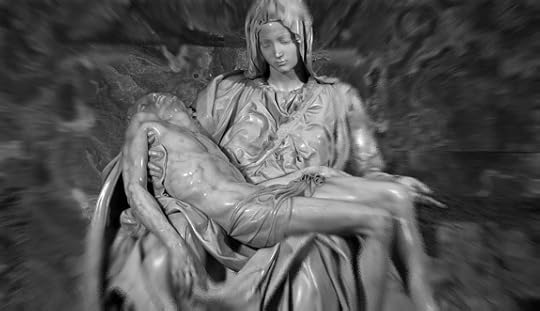
"They Killed Him": Deicide and Holy Saturday | Dr. Leroy Huizenga | Catholic World Report
The Christ is dead; the corpse of
the Son of God lies on a cold slab in a suffocating, lightless tomb.
Holy Saturday is a difficult day to
keep holy. My parish marks it with morning prayer from the Liturgy of the
Hours, but most churches don’t do anything, which is certainly appropriate;
Jesus Christ is liturgically dead. And so I’ve taken to my own observances.
Last year after the Good Friday communion liturgy, my wife and I watched The
Passion of the Christ, and on Holy Saturday we kept things low-key while
listening to Bach’s Matthäus-Passion and Johannes-Passion as well as Mozart’s
and Verdi’s Requiems.
But life goes on. Our young kids
(almost 5 and 3) can’t help but play, sometimes cooperating, sometimes
protesting in shrill tones some grave injustice the other has perpetrated by
encroaching on (say) a Thomas the Tank Engine track layout. My mother will host
Easter dinner, and so we will prepare some food for that. And for many people,
even those who will be in Easter Sunday services tomorrow, Holy Saturday is
another Saturday filled with shopping, yardwork, fishing, and the like.
Holy Saturday started to hit me
differently a few years ago. I suspect it had to do with three major events
occurring within a period of several months. First, I turned 35, which meant my
life was half over, as I’d count myself blessed to make it to seventy. I began
to feel life was now downhill. Second, our son Hans was born, and as those of
you who are parents know, having children entails epistemological paradigm
shifts: we see the world differently. Third, just a few weeks after Hans’
birth, I buried my father. And so I came to the existential realization that
life was short and moving ever faster and that we play for keeps.
Sensitive now to the fragility of
human life and the grave responsibilities laid upon us by God and Nature and
newly alive to the joys and terrors of life in this beautiful and horrible
world as a member of a glorious and murderous race, Holy Saturday punched me in
the gut.
They killed him. They really did.
Many Christians in modernity, I
think, have a conception of the crucifixion restricted to a legal version of
penal substitutionary atonement: Our problem is guilt, for which God must
punish us, but loving us and desiring to forgive us, God punishes Christ in our
place.
The Cross, For Us
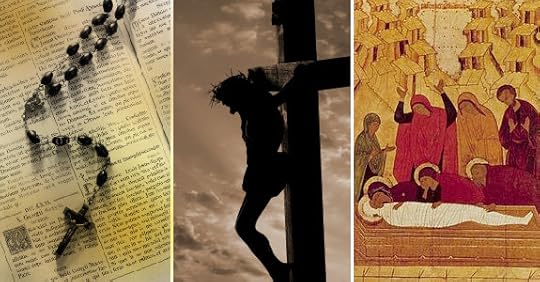
The Cross, For Us | Hans Urs von Balthasar
Whoever removes the Cross from the center of Christianity no longer stands in continuity with the apostolic faith
The following is from A Short Primer for Unsettled Laymen (Ignatius Press, 1985).
Without a doubt, at the center of the New Testament there stands the Cross,
which receives its interpretation from the Resurrection.
The Passion narratives are the first pieces of the Gospels that were composed
as a unity. In his preaching at Corinth, Paul initially wants to know
nothing but the Cross, which "destroys the wisdom of the wise and wrecks
the understanding of those who understand", which "is a scandal to the
Jews and foolishness to the gentiles". But "the foolishness of God is
wiser than men, and the weakness of God is stronger than men" (1 Cor 1:19,
23, 25).
Whoever removes the Cross and its interpretation
by the New Testament from the center, in order to replace it, for example,
with the social commitment of Jesus to the oppressed as a new center,
no longer stands in continuity with the apostolic faith. He does not see
that God's commitment to the world is most absolute precisely at this
point across a chasm.
It is certainly not surprising that the disciples were able to understand
the meaning of the Cross only slowly, even after the Resurrection. The
Lord himself gives a first catechetical instruction to the disciples at
Emmaus by showing that this incomprehensible event is the fulfillment
of what had been foretold and that the open question marks of the Old
Testament find their solution only here (Lk 24:27).
Which riddles? Those of the Covenant between God
and men in which the latter must necessarily fail again and again: who
can be a match for God as a partner? Those of the many cultic sacrifices
that in the end are still external to man while he himself cannot offer
himself as a sacrifice. Those of the inscrutable meaning of suffering
which can fall even, and especially, on the innocent, so that every proof
that God rewards the good becomes void. Only at the outer periphery, as
something that so far is completely sealed, appear the outlines of a figure
in which the riddles might be solved.
This figure would be at once the completely kept
and fulfilled Covenant, even far beyond Israel (Is 49:5-6), and the personified
sacrifice in which at the same time the riddle of suffering, of being
despised and rejected, becomes a light; for it happens as the vicarious
suffering of the just for "the many" (Is 52:13-53:12). Nobody had understood
the prophecy then, but in the light of the Cross and Resurrection of Jesus
it became the most important key to the meaning of the apparently meaningless.
Did not Jesus himself use this key at the Last Supper in anticipation?
"For you", "for the many", his Body is given up and his Blood is poured
out. He himself, without a doubt, foreknew that his will to help these"
people toward God who are so distant from God would at some point be taken
terribly seriously, that he would suffer in their place through this distance
from God, indeed this utmost darkness of God, in order to take it from
them and to give them an inner share in his closeness to God. "I have
a baptism to be baptized with, and how I am constrained until it is accomplished!"
(Lk 12:50).
It stands as a dark cloud at the horizon of his active life; everything
he does then-healing the sick, proclaiming the kingdom of God, driving
out evil spirits by his good Spirit, forgiving sins-all of these partial
engagements happen in the approach toward the one unconditional engagement.
As soon as the formula "for the many", "for you", "for us", is found,
it resounds through all the writings of the New Testament; it is even
present before anything is written down (cf. i Cor 15:3). Paul, Peter,
John: everywhere the same light comes from the two little words.
What has happened? Light has for the first time penetrated into the closed
dungeons of human and cosmic suffering and dying. Pain and death receive
meaning.
Not only that, they can receive more meaning and
bear more fruit than the greatest and most successful activity, a meaning
not only for the one who suffers but precisely also for others, for the
world as a whole. No religion had even approached this thought. [1] The
great religions had mostly been ingenious methods of escaping suffering
or of making it ineffective. The highest that was reached was voluntary
death for the sake of justice: Socrates and his spiritualized heroism.
The detached farewell discourses of the wise man in prison could be compared
from afar to the wondrous farewell discourses of Christ.
But Socrates dies noble and transfigured; Christ
must go out into the hellish darkness of godforsakenness, where he calls
for the lost Father "with prayers and supplications, with loud cries and
tears" (Heb 5:7). Why are such stories handed down? Why has the image
of the hero, the martyr, thus been destroyed? It was "for us", "in our
place".
One can ask endlessly how it is possible to take someone's place in this
way. The only thing that helps us who are perplexed is the certainty of
the original Church that this man belongs to God, that "he truly was God's
Son", as the centurion acknowledges under the Cross, so that finally one
has to render him homage in adoration as "my Lord and my God" Jn 20:28).
Every theology that begins to blink and stutter at this point and does
not want to come out with the words of the Apostle Thomas or tinkers with
them will not hold to the "for us". There is no intermediary between a
man who is God and an ordinary mortal, and nobody will seriously hold
the opinion that a man like us, be he ever so courageous and generous
in giving himself, would be able to take upon himself the sin of another,
let alone the sin of all. He can suffer death in the place of someone
who is condemned to death. This would be generous, and it would spare
the other person death at least for a time.
But what Christ did on the Cross was in no way intended to spare us death
but rather to revalue death completely. In place of the "going down into
the pit" of the Old Testament, it became "being in paradise tomorrow".
Instead of fearing death as the final evil and begging God for a few more
years of life, as the weeping king Hezekiah does, Paul would like most
of all to die immediately in order "to be with the Lord" (Phil 1:23).
Together with death, life is also revalued: "If we live, we live to the
Lord; if we die, we die to the Lord" (Rom 14:8).
But the issue is not only life and death but our existence before God
and our being judged by him. All of us were sinners before him and worthy
of condemnation. But God "made the One who knew no sin to be sin, so that
we might be justified through him in God's eyes" (2 Cor 5:21).
Only God in his absolute freedom can take hold of our finite freedom from
within in such a way as to give it a direction toward him, an exit to
him, when it was closed in on itself. This happened in virtue of the "wonderful
exchange" between Christ and us: he experiences instead of us what distance
from God is, so that we may become beloved and loving children of God
instead of being his "enemies" (Rom 5:10).
Certainly God has the initiative in this reconciliation: he is the one
who reconciles the world to himself in Christ. But one must not play this
down (as famous theologians do) by saying that God is always the reconciled
God anyway and merely manifests this state in a final way through the
death of Christ. It is not clear how this could be the fitting and humanly
intelligible form of such a manifestation.
No, the "wonderful exchange" on the Cross is the way by which God brings
about reconciliation. It can only be a mutual reconciliation because God
has long since been in a covenant with us. The mere forgiveness of God
would not affect us in our alienation from God. Man must be represented
in the making of the new treaty of peace, the "new and eternal covenant".
He is represented because we have been taken over by the man Jesus Christ.
When he "signs" this treaty in advance in the name of all of us, it suffices
if we add our name under his now or, at the latest, when we die.
Of course, it would be meaningless to speak of the Cross without considering
the other side, the Resurrection of the Crucified. "If Christ has not
risen, then our preaching is nothing and also your faith is nothing; you
are still in your sins and also those who have fallen asleep . . . are
lost. If we are merely people who have put their whole hope in Christ
in this life, then we are the most pitiful of all men" (1 Cor 15:14, 17-19).
If one does away with the fact of the Resurrection, one also does away
with the Cross, for both stand and fall together, and one would then have
to find a new center for the whole message of the gospel. What would come
to occupy this center is at best a mild father-god who is not affected
by the terrible injustice in the world, or man in his morality and hope
who must take care of his own redemption: "atheism in Christianity".
Endnotes:
[1] For what is meant here is something qualitatively completely different
from the voluntary or involuntary scapegoats who offered themselves or
were offered (e.g., in Hellas or Rome) for the city or for the fatherland
to avert some catastrophe that threatened everyone.
March 28, 2013
The Violence of the Crucifixion
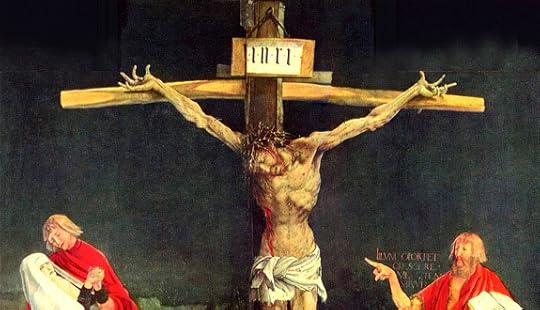
The Violence of the Crucifixion | Dr. Leroy
Huizenga | Catholic World Report
The Four Evangelists glory not in the cross’ gore but rather in its shame
One of my
duties at the University of Mary in Bismarck, ND, where I chair the Theology
Department, is to help our student music leaders select music appropriate for
our well-attended masses. For a recent Wednesday in Lent, for offertory and
communion the students selected “O Sacred Head Surrounded,” familiar to many,
as well as “Glory Be to Jesus,” an eighteenth-century Italian hymn translated
into English in the nineteenth.
The hymn we
know as “O Sacred Head Surrounded” originated in Latin in the middle ages. The
famous tune and words appear in the Passion Chorale in Bach’s St. Matthew
Passion. German often sounds blunt to English ears, and the rendering of O
Haupt voll Blut und Wunden / Voll Schmerz und voller Hohn in the English hymn is as brutal as the German: O
Sacred Head surrounded / by crown
of piercing thorn! / O bleeding head, so wounded / reviled and put to
scorn! The second stanza likewise speaks of death with cruel rigor and agony and dying. “Glory Be to Jesus” is similar, especially in the
first stanza: Glory Be to Jesus / Who in bitter pains / Poured for me
the lifeblood / from his sacred veins.
Having
reviewed the lineup for the mass before the worship aid was to go to print, a
member of our campus ministry team sent an email in which she wondered if the
repeated references to Jesus’ corporal suffering weren’t a bit much, especially
when presented in such a blunt and baroque fashion. My first thought was that
it was deep into Lent, and so some lyrical reminders of the depths of the
suffering of Christ were entirely appropriate. But our first reactions are not
always right, and while we kept the hymns in place, in thinking about it I came
to see my colleague had made a good point.
The hymns themselves
are wonderful in tune and lyric; there’s nothing essentially wrong with them.
But my friend’s instincts were good, for too often Christians focus on the gore
involved in the torture and crucifixion of our Lord and miss out on the deeper
violence of the crucifixion, the violence on which ancient writers and the
Evangelists themselves concentrate.
Pope Francis and Henri de Lubac, SJ
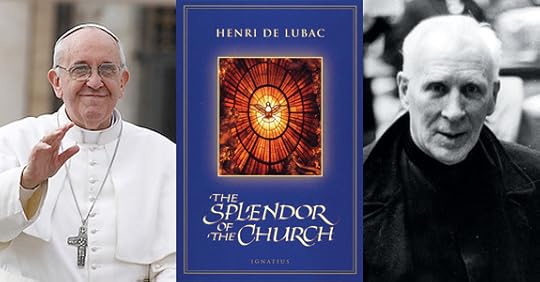
Pope Francis and Henri de Lubac, SJ | Carl E. Olson | CWR blog
Sandro Magister reports:
It is a widespread opinion, confirmed by numerous testimonies, that the
intention of electing pope Jorge Mario Bergoglio grew substantially
among the cardinals on the morning of Saturday, March 9, when the
then-archbishop of Buenos Aires spoke at the second to last of the
congregations - covered by secrecy - that preceded the conclave.
His
words made an impression on many. Bergoglio spoke off the cuff. But we
now have the account of those words of his, written by the hand of the
author himself.
Bergoglio's remarks in the preconclave were made
public by the cardinal of Havana, Jaime Lucas Ortega y Alamino, in the
homily of the chrism Mass that he celebrated on Saturday, March 23 in
the cathedral of the capital of Cuba, in the presence of the apostolic
nuncio, Archbishop Bruno Musarò, of the auxiliary bishops Alfredo Petit
and Juan de Dios Hernandez, and of the clergy of the diocese.
Cardinal
Ortega recounted that after the remarks of Bergoglio in the
preconclave, he had approached him to ask if he had a written text that
he could keep.
Bergoglio responded that at the moment he did not
have one. But the following day - Ortega recounted - "with extreme
delicacy” he gave him “the remarks written in his own hand as he
recalled them."
Ortega asked him if he could release the text, and Bergoglio said yes.
Here is that text of Cardinal Bergoglio's notes:
Reference has been made to evangelization. This is the Church's reason
for being. “The sweet and comforting joy of evangelizing” (Paul VI). It
is Jesus Christ himself who, from within, impels us.
1)
Evangelizing implies apostolic zeal. Evangelizing presupposes in the
Church the “parresia" of coming out from itself. The Church is called to
come out from itself and to go to the peripheries, not only
geographical, but also existential: those of the mystery of sin, of
suffering, of injustice, those of ignorance and of the absence of faith,
those of thought, those of every form of misery.
2) When the
Church does not come out from itself to evangelize it becomes
self-referential and gets sick (one thinks of the woman hunched over
upon herself in the Gospel). The evils that, in the passing of time,
afflict the ecclesiastical institutions have a root in
self-referentiality, in a sort of theological narcissism. In Revelation,
Jesus says that he is standing at the threshold and calling. Evidently
the text refers to the fact that he stands outside the door and knocks
to enter. . . But at times I think that Jesus may be knocking from the
inside, that we may let him out. The self-referential Church presumes to
keep Jesus Christ within itself and not let him out.
3) The
Church, when it is self-referential, without realizing it thinks that it
has its own light; it stops being the “mysterium lunae" and gives rise
to that evil which is so grave, that of spiritual worldliness (according
to De Lubac, the worst evil into which the Church can fall): that of
living to give glory to one another. To simplify, there are two images
of the Church: the evangelizing Church that goes out from itself; that
of the “Dei Verbum religiose audiens et fidenter proclamans" [the Church
that devoutly listens to and faithfully proclaims the Word of God -
editor's note], or the worldly Church that lives in itself, of itself,
for itself. This should illuminate the possible changes and reforms to
be realized for the salvation of souls.
4) Thinking of the next
Pope: a man who, through the contemplation of Jesus Christ and the
adoration of Jesus Christ, may help the Church to go out from itself
toward the existential peripheries, that may help it to be the fecund
mother who lives “by the sweet and comforting joy of evangelizing.”
Rome, March 9, 2013
The influence of de Lubac, one of the finest Jesuit theologians of the past century, on Bergoglio is also obvious in this 2007 interview, which ends with this remark:
Carl E. Olson's Blog
- Carl E. Olson's profile
- 20 followers



